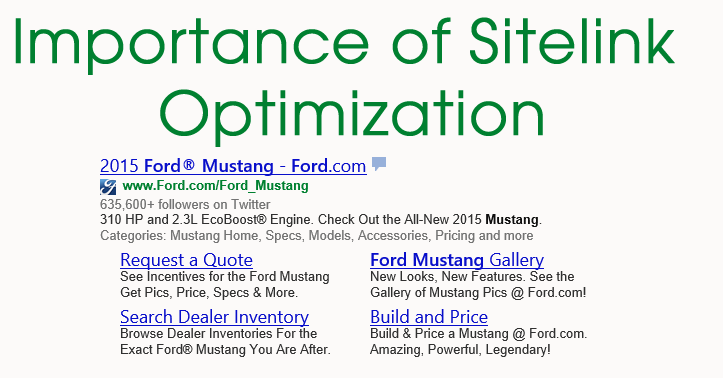If asked, every search marketer worth her or his salt would likely claim to be well-versed in developing appealing ads, crafting keyword-rich ad text and even making data-driven ad optimization decisions. Yet just how many search marketers regularly extend their ad analysis to the bottom half of the ad?
Search marketers know about the importance of sitelinks to be sure, given that they can produce a double digit increase in CTR. Though when it comes to creating sitelinks, most search marketers consider them merely to be a “check-the-box activity;” consequently many search marketers don’t include sitelinks as a part of the ad optimization process, despite the fact that sitelinks can make up the majority (nope, that’s not a typo) of an ad’s real estate!
In today’s article I will use actual examples to illustrate why optimizing sitelinks is a crucial activity not to be ignored, describe how to report on sitelink performance and teach you some tips and tricks to optimize your sitelinks, all from the platform that captures nearly one third of the US search audience: Bing Ads!
Basic Sitelinks – Stackable, but only if you maximize them
There are 2 main types of sitelink extensions: basic and enhanced. Basic sitelinks require only link text (that shows as the actual hyperlinked text) and a destination URL. As you can see in these examples below, using 2 sitelinks arranges them side-by-side, however adding more sitelinks stacks them into a vertical block, with up to 6 showing at once. Make sure to create at least 6 sitelinks in order to capitalize on the maximum number allowed in a sitelink block and enable your ads can capture as large a portion of the SERP as possible.
Enhanced Sitelinks– a Massive Opportunity
Enhanced sitelinks enable you to add up to 2 descriptive lines for each individual sitelink. Furthermore, using enhanced sitelinks increases the size of each sitelink description text to title size proportions. Not only is this is a huge opportunity to go on the offensive in pushing competitor ads down the page by doubling the height of your ad, but it also quadruples the ad text that your ad can display. When creating description lines, be sure to fill out description lines for each individual sitelink; filling out a description for fewer than 4 sitelink texts will prevent any enhanced descriptions from showing. Check out this blog post to learn more about enhanced sitelink specifics tech specs.
In Bing Ads, performance data can be displayed on the individual sitelink text level, which makes reporting a breeze. To report on data points like CTR, conversion rate or CPA for your individual sitelinks, begin by navigating to the report tab using the top of page, black navigation bar in the Bing Ads UI. As an FYI you can see a description of what each report shows and why each is useful by clicking on the category headers (i.e. performance, change history, targeting, campaign analytics and billing and budget) located inside the wunderbar, which is situated in the left-hand side of the page; if you don’t see the wunderbar, click the rightward-facing arrow to reveal the wunderbar.
To report on sitelink performance we will select ad extension by details, which is one of the three ad extension reports available:
- Ad extension by ad – this report will show performance data broken out by each extension click type for each of your ads. Click types include:
o Sitelink clicks
o Ad title (headline) clicks
o Phone call clicks (via call extensions)
o Driving direction clicks (via location extensions)
- Ad extension by keyword – this report will show performance data broken out by each extension click type for each of your keywords.
- Ad extension by details – this report will show performance data by ad extension type, ID and property value.
Select the last report (ad extension by details), adjust your report settings, date range and columns and then click run. Ad extension display name is what we will load into our pivot table row and to pivot by the actual sitelink extension text from your campaigns or ad groups.
The first graph here provides a prime example of what sitelink analysis can uncover. As we can see, sitelink #8 has a stupendous CTR while sitelinks #4-#6 have terrible CTRs. By identifying our under and over-performing sitelinks, we can make data-driven decisions and improve campaign performance all-up!
This second example takes our analysis to a deeper level of insight above and beyond what we could uncover in example #1 (hint: make sure you have conversion tracking set up!) by allowing us to apply a conversion-based lens to our analysis. Thanks to the data below, we now have a whole host of optimization options we otherwise would not have known existed. Here are some ways in which we could act on this data:
- Run an ad extension by keyword report to determine whether the poor performance from sitelinks #9 and #8 are due to a particular keyword, rather than the sitelinks themselves.
- Performing funnel conversion rate analysis for the product linked to sitelink #9.
- Test a new product/page in place of sitelink #8.
- Ensure sitelinks #6 and #15 are placed first and second in the sitelink order so that they show in the best positions.
- Use a complimentary or upsell product for sitelinks #6 and #15 in place of an underperforming sitelink.
Sitelink Optimization – Tips & Tricks
- Use of a unique destination URL in Bing Ads is not required, which makes adding sitelinks for websites with one page (like splash pages) much easier than in Google!
- Optimize your sitelink length for mobile devices using the mobile preference option. If your sitelinks are too long they may not end up showing fully like this Mazda ad below; test your sitelinks on a mobile device and shorten your sitelink text if yours are being truncated.
- Make sure that your bids are competitive enough to show ads in the right location. Sitelinks will only show in the mainline/top position, so use the top vs other metric (rather than average position) to see which keywords are not showing ads in the mainline and optimize those keyword bids.
- Run an ad extension by keyword report to see which keywords produce the highest sitelink CTR and try testing those keywords in your sitelink text, description or in your ad itself!
- Make sitelinks as specific as possible. Don’t just check the box by creating campaign-level sitelinks; if you have heterogeneous products within a campaign, create ad group-level sitelinks for each product; for homogenous campaigns, try testing deep links to popular or complimentary products!
- Have a tough sell product? Use your sitelink description lines to help explain the value of your product and provide links to testimonials, reviews or price comparisons!
- Order the sitelinks that you want to show up in best (sitelink) position first. Bing will give positional preference to sitelinks that have a higher CTR, however you can indicate your positional preference via the way you arrange your sitelinks.
That’s all for today! Thank you for following along, and as always feel free to ask questions, comment and add your own flavor of insight. Happy optimizing!
-Gabe
Gabe Kwakyi
Latest posts by Gabe Kwakyi (see all)
- Optimizing Bing Shopping Campaigns – Part 2 - October 19, 2015
- Optimizing Bing Shopping Campaigns – Part 1 - October 5, 2015
- 5 PPC Optimization Strategies You Should Be Doing But Probably Aren’t - April 9, 2015
- Don’t Skip the Side of Sitelink Optimization - February 17, 2015
- The Bing Ads Campaign Planner Tool – Search Geeks Rejoice! - December 3, 2014




